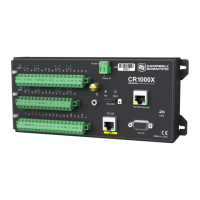measurement measures the high signal with reference to ground; the low signal is tied to
ground. A differential measurement measures the high signal with reference to the low signal.
Each configuration has a purpose, but the differential configuration is usually preferred.
In general, use the smallest input range that accommodates the full-scale output of the
sensor. This results in the best measurement accuracy and resolution (see Analogue
measurements specifications (p. 166) for more information).
A set overhead reduces the chance of overrange. Overrange limits are available in the
specifications. The datalogger indicates a measurement overrange by returning a NAN for the
measurement.
WARNING:
Sustained voltages in excess of ±20 V applied to terminals configured for analogue input
will damage CR1000X circuitry.
6.1.1 Single-ended measurements
A single-ended measurement measures the difference in voltage between the terminal
configured for single-ended input and the reference ground. For example, single-ended channel
1 is comprised of terminals SE 1 and . Single-ended terminals are labelled in blue. For more
information, see Wiring panel and terminal functions (p. 5). The single-ended configuration is
used with the following CRBasic instructions:
l
VoltSE()
l
BrHalf()
l
BrHalf3W()
l
TCSE()
l
Therm107()
l
Therm108()
l
Therm109()
6.1.2 Differential measurements
A differential measurement measures the difference in voltage between two input terminals. For
example, DIFF channel 1 is comprised of terminals 1H and 1L, with 1H as high and 1L as low. For
more information, see Wiring panel and terminal functions (p. 5). The differential configuration
is used with the following CRBasic instructions:
l
VoltDiff()
l
BrFull()
l
BrFull6W()
6. Measurements 47

